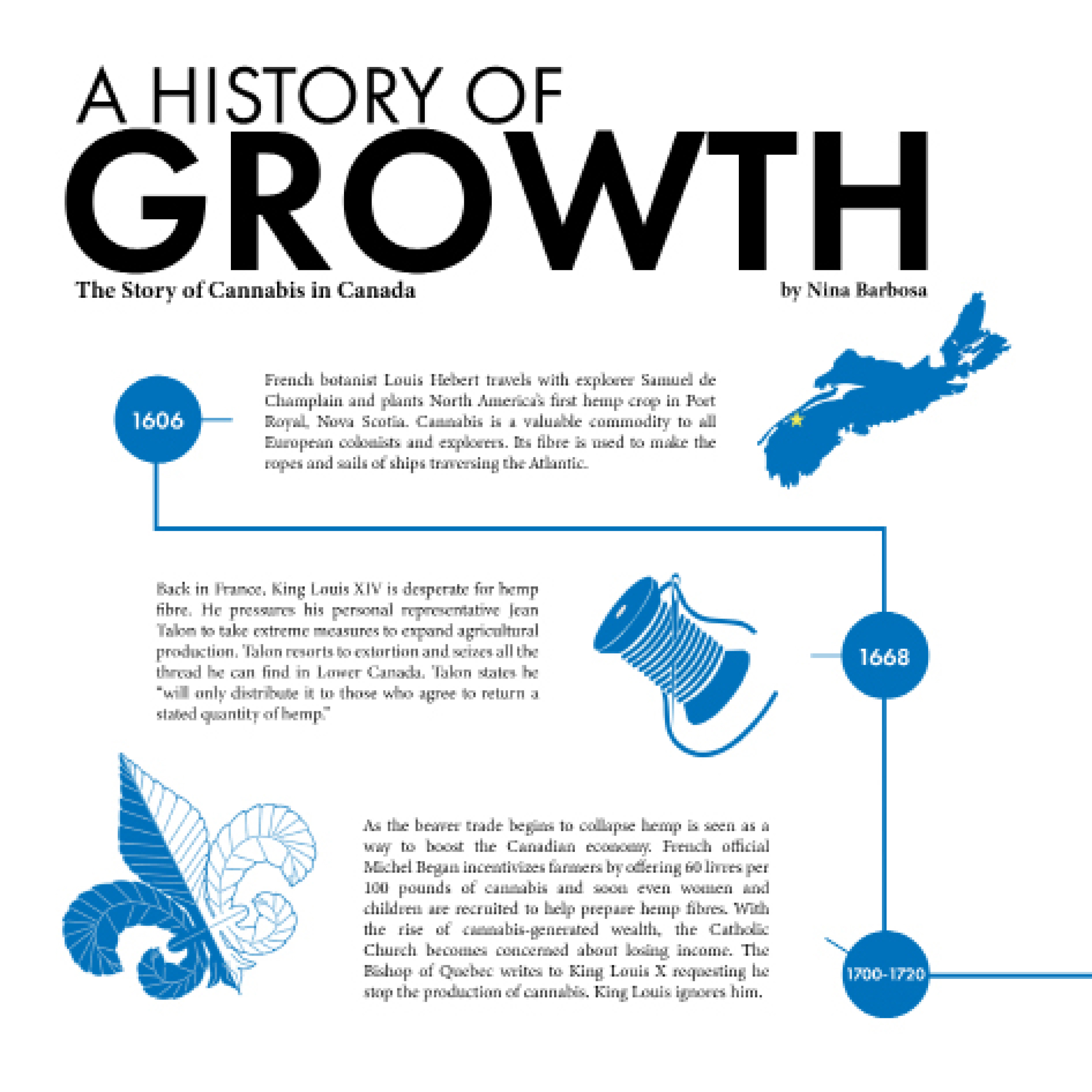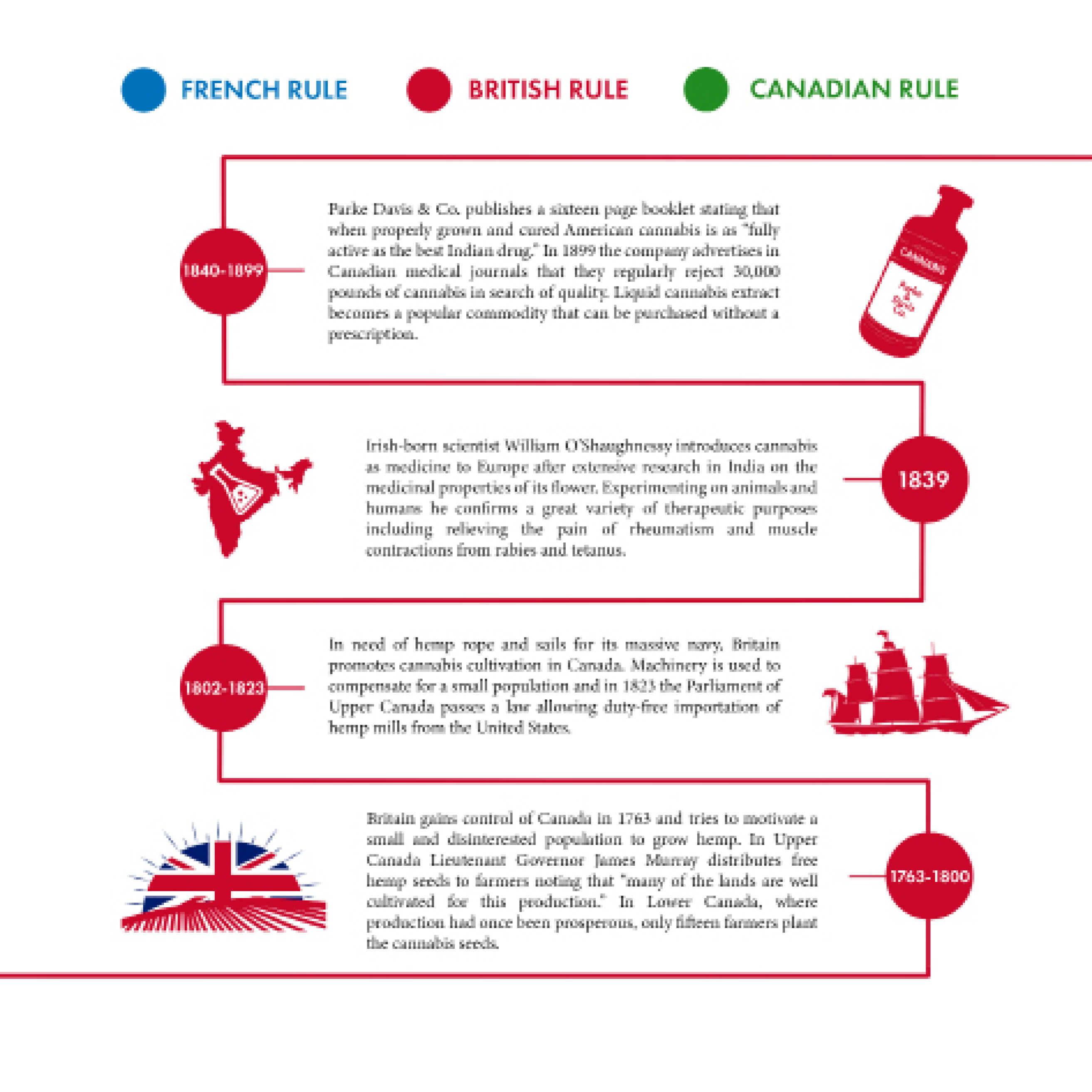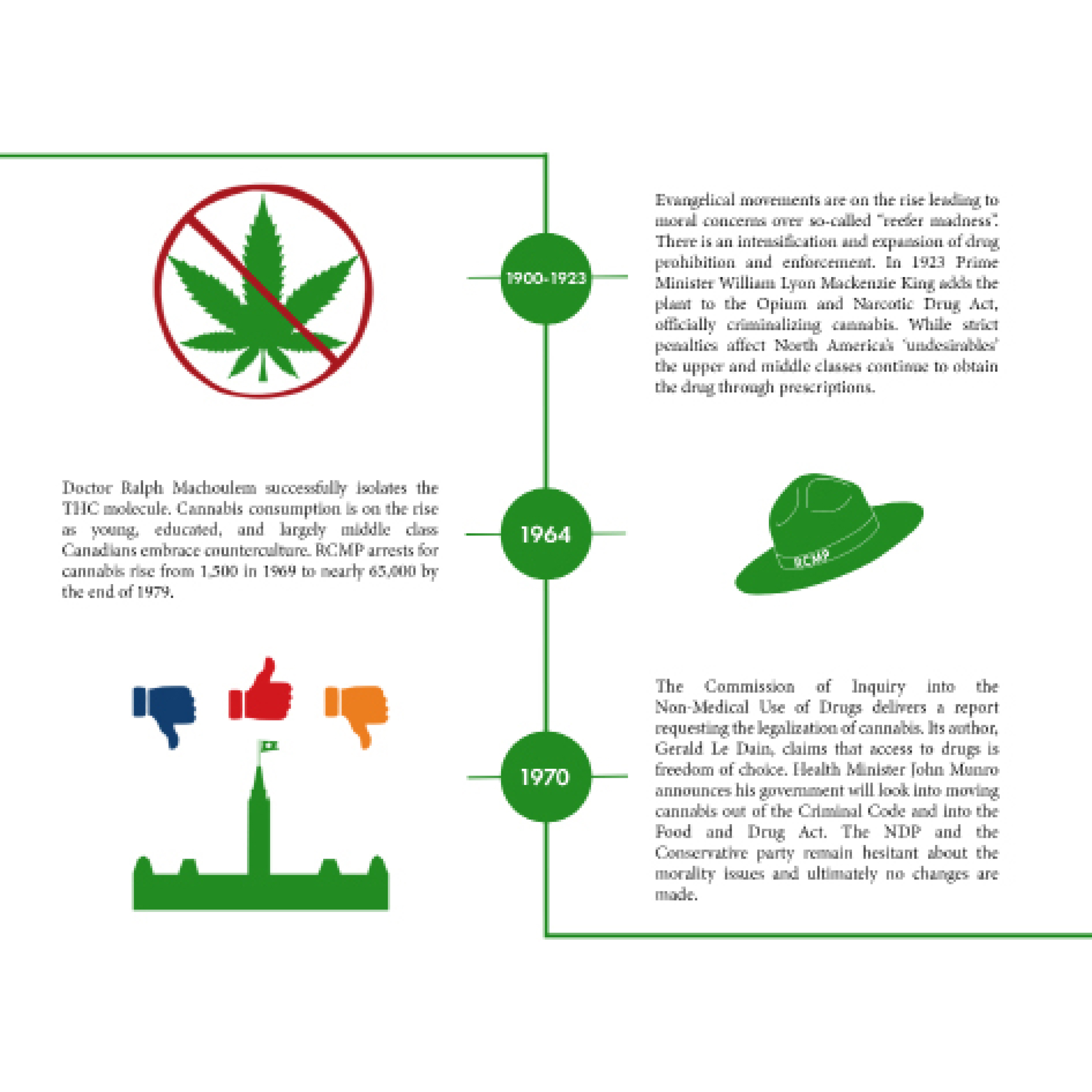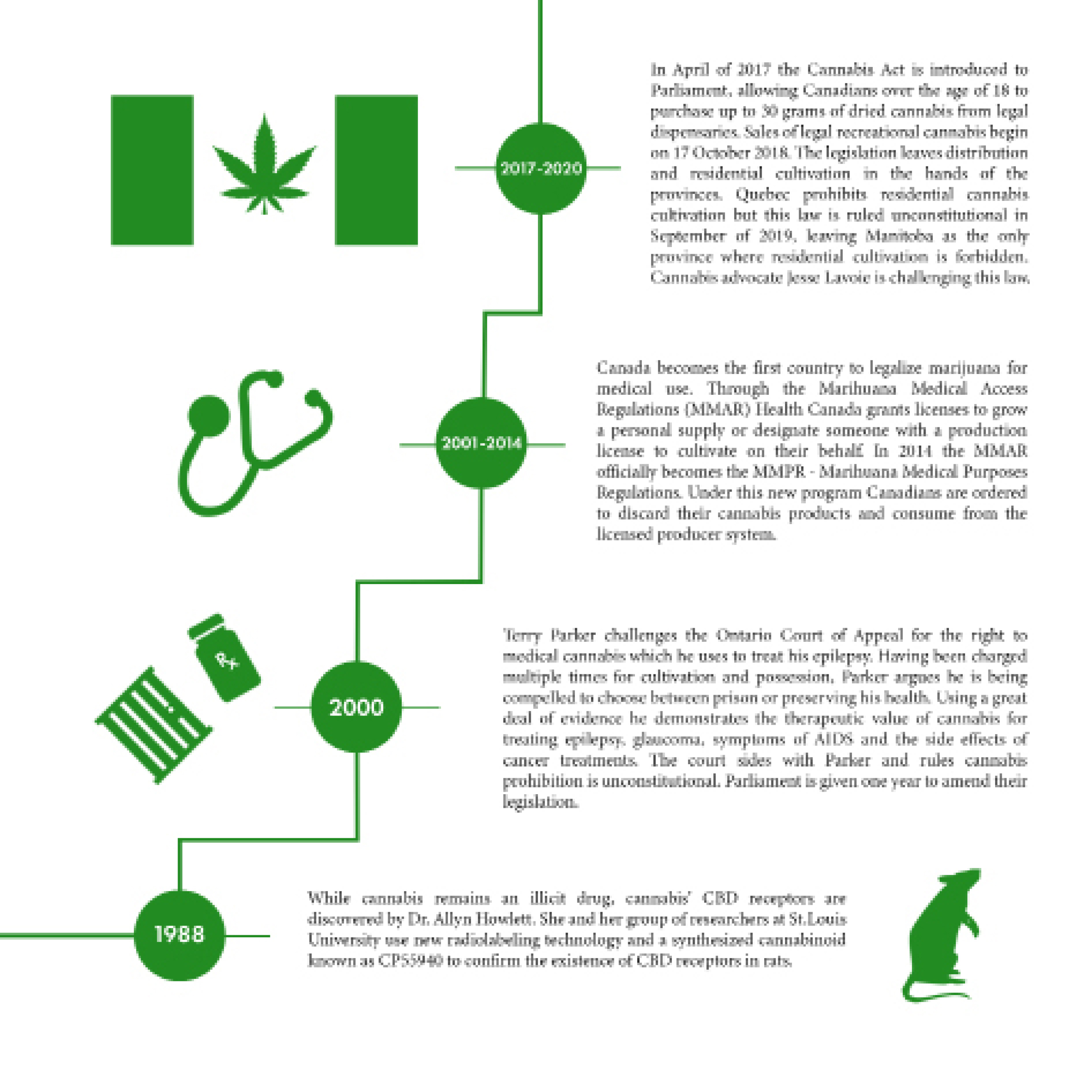Presented below is a timeline of events related to cannabis in Canada. Everything notable in the history of weed in Canada, from growing hemp in Nova Scotia in Quebec for the Royal Navy’s sails all the way up to Canadian court cases in the early 2000’s that helped shape legislation, is included here below. See something missing? Add it in the comments below!

1606
French botanist Louis Hebert travels with explorer Samuel de Champlain and plants North America’s first hemp crop in Port Royal, Nova Scotia. Cannabis is a valuable commodity to all European colonists and explorers. Its fiber is used to make the ropes and sales of ships traversing the Atlantic.
1668
Back in France, King Louis XIV is desperate for hemp fiber. He pressures his personal representative, Jean Talon, to take extreme measures to expand agricultural production. Talon resorts to extortion and seizes all the thread he can find in Lower Canada. Talon states he “will only distribute it to those who agree to return a stated quantity of hemp.”
1700-1720
As the beaver trade begins to collapse hemp is seen as a way to boost the Canadian economy. French official Michel Began incentivizes farmers by offering 60 livres per 160 pounds of cannabis and soon even women and children are recruited to help prepare hemp fibers. With the rise of cannabis-generated wealth, the Catholic Church becomes concerned about losing income. The Bishop of Quebec writes to King Louis X requesting he stop the production of cannabis. King Louis ignores him.

1763-1800
Britain gains control of Canada in 1763 and tries to motivate a small and disinterested population to grow hemp. In Upper Canada, Lieutenant Governor James Murray distributes free hemp seeds to farmers noting that “many of the lands are well cultivated for this production.” In Lower Canada, where production had once been prosperous, only fifteen farmers plant the cannabis seeds.
1802-1823
In need of hemp rope and sails for its massive navy, Britain promotes cannabis cultivation in Canada. Machinery is used to compensate for a small population and in 1823 the Parliament of Upper Canada passes a law allowing duty-free importation of hemp mills from the United States.
1839
Irish-born scientist William O’Shaugnessy introduces cannabis as a medicine to Europe after extensive research in India on the medicinal properties of its flower. Experimenting on animals and humans he confirms a great variety of therapeutic purposes including relieving the pain of rheumatism and muscle contractions from rabies and tetanus.
1840-1899
Parke Davis and Company publishes a 16 page booklet stating that when properly grown and cured, American cannabis is as “fully active as the best Indian drug.” In 1899 the company advertises in Canadian medical journals that they regularly reject 30,000 pounds of cannabis in search of quality. Liquid cannabis extract becomes a popular commodity that can be purchased without a prescription.

1900-1923
Evangelical movements are on the rise leading to moral concerns over so-called “reefer madness.” There is an intensification and expansion of drug prohibition and enforcement. In 1923, Prime Minister William Lyon Mackenzie King adds the plant to the Opium and Narcotic Drug Act, officially criminalizing cannabis. While strict penalties affect North America’s “undesirables”, the upper and middle classes continue to obtain the plant through prescriptions.
1964
Doctor Ralph Mechoulam successfully isolates the THC molecule. Cannabis consumption is on the rise as young, educated and largely middle class Canadians embrace counterculture. RCMP arrests for cannabis rise from 1,500 in 1969 to nearly 65,000 by the end of 1979.
1970
The Commission of Inquiry into the Non-Medical Use of Drugs delivers a report requesting the legalization of cannabis. Its author, Gerald Le Dain, claims that access to drugs is freedom of choice. Health Minister John Munro announces his government will look into moving cannabis out of the Criminal Code and into the Food and Drug Act. The NDP and the Conservative partyies remain hesitant about the morality issues and ultimately no changes are made.

1988
While cannabis remains an illicit drug, cannabis’ CBD receptors are discovered by Dr. Allyn Howlett. She and her group of researchers at S. Louis University use new radio-labelling technology and a synthesized cannabinoid known as CP55940 to confirm the existence of CBD receptors in rats.
2000
Terry Parker challenges the Ontario Court of Appeal for the right to medical cannabis which he uses to treat his epilepsy. Having been charged multiple times for cultivation and possession, Parker argues he is being compelled to choose between prison or preserving his health. Using a great deal of evidence he demonstrates the therapeutic value of cannabis for treating epilepsy, glaucoma, symptoms of AIDS and the side effects of cancer treatments. The court sides with Parker and rules cannabis prohibition is unconstitutional. Parliament is given one year to amend their legislation.
2001-2014
Canada becomes the first country to legalize marijuana for medical use. Through the Marihuana Medical Access Regulations (MMAR), Health Canada grants licenses to grow a personal supply or designate someone with a production license to cultivate on their behalf. In 2014 the MMAR officially becomes the MMPR – Marihuana Medical Purposes Regulations. Under this new program Canadians are ordered to discard their cannabis products and consume from the licensed producer system.
2017-2020
In April of 2017, the Cannabis Act is introduced to Parliament, allowing Canadians over the age of 18 to purchase up to 30 grams of dried cannabis from legal dispensaries. Sales of legal recreational cannabis begin on 17 October 2018. The legislation leaves distribution and residential cultivation in the hands of the provinces. Quebec prohibits residential cannabis cultivation but this law is ruled unconstitutional in September of 2019, leaving Manitoba as the only province where residential cultivation is forbidden for recreational purposes. Cannabis advocate Jesse Lavoie is challenging the Manitoban law and has joined the fight against Quebec’s appeal of their 2019 ruling.



